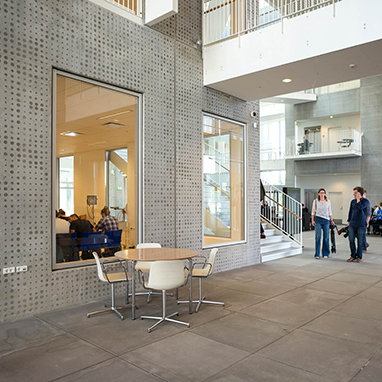There is power in subtlety
BY LINDA HIRVONEN
1.6.2022
If you consider yourself to be a construction professional who is not a big fan of ornaments, but who appreciates clean design, subtle expression and homogenous materials, this writing is for you.
You might have noticed that when graphic concrete is mentioned, quite often one tends to think about strong contrasts, photographs or decorative intricacies. The reason this is so, is quite obvious, since images tend to leave a mark in our memory.
This is made quite clear, when for example looking at the art piece by graphic concrete's inventor, awarded industrial designer Samuli Naamanka, the high contrast of the art with dandelion fluf for Talvikangas School. It is hard not to notice.

Photo: Talvikangas School graphic concrete designed by Samuli Naamanka has a high contrast to the chosen
concrete. This is one of the perfect example of graphic concrete as a technique for art.
It is just a fact that our eyes are drawn to these beautiful pieces, it is just how our brains function. And these impactful pieces do have a place in the world of architecture and design to make an impact and highlight the architectural details. But as beautiful as these pieces are, it is not always emphasized, that graphic concrete is so much more than figurative patterns.
Everything has its place, but after working for more than a decade in the world of graphic concrete patterns and images, I think it’s time to elevate alternative ways to incorporate a graphic design to a building. A way that highlights and supports the architecture in a sophisticated manner.
So allthough there is definitely power in images, there is also great power in subtle expression.


Photo: Curved Graphic Concrete panels can be seen on the facade and inside the Kochi Castle Museum of History
in Kochi, Japan. The pattern design ”TimberWall” was inspired by works of Yamauchi Kazutoyo, who built the
Kochi Castle (1601-1611) and whose art collections are permanently exhibited in the museum.
You may have not realized it, but graphic concrete is quite often used to create a surface texture to a façade. In these buildings one does not necessarily notice graphic concrete, when the façade seams to have an interesting surface texture and not a figurative pattern.
In the Kochi Castle Museum of History in Japan, the subtle and thematic wood grain pattern emphesizes the curved form. Here the architecture makes the statement and the textured pattern supports it.



Photo: Scandionklinik Hospital's clean form combined with the use of wood and textured façade surface.
It might come as a surprise, that the use of graphic concrete technique as a surface texture is actually quite common.
As seen in façade of Skandion Clinic, according to the Architect Carl Fredrik Danielson from Link Arkitektur: "We have tried to achieve a ‘textile’ effect with the pattern to give the large volumes a human appearance."
The surface textures and subtle patterns of graphic concrete stand the test of time in more ways than the words literal meaning, as the patterning is not tied to the prevailing design trends. They are safe to use and as always with any graphic concrete pattern as durable as the concrete.
So in order to achieve the surface texture outcome, you have two choices, you may either design a pattern of your own or choose from Graphic Concrete's GCCollection consisting of over a hundred ready made patterns.
As quite often schedules might be too strict to have a bespoke design, we have many texture patterns in our GCCollection for you to choose from. Here are just a few examples:
Photos: GCCollection patterns: Ikat, Textilia, Round Rough, Hair
It is also good to know, that our GCCollection patterns can be edited, scaled or distorded in any way to give a bespoke feel.
But given the opportunity it can be quite intriguing to design your own pattern from the start. So in case you are able to to dive into the creative process of pattern design, here are a few things that are good to consider:
- In case you are new to graphic concrete or patterns design start by getting familiar with the graphic concrete Design Instructions.
- For a textured pattern create a seamles design that continues in every direction, but one that does not need positioning to the façade. Here is a tip to creating a seamless repetitive pattern in a few simple steps.
- The repetitive pattern size is recommended to stay withing the area of 3200x3200mm. This also counts towards cost efficiency.
For further instructions, consultation or design training you are always more than welcome to contact us.









Differet surface textures can be seen in quite many Graphic Concrete references.
It’s also good to keep in mind that patterns like these are the most cost-efficient ones. A true win-win situation for all, right? At least in my opinion this is the best combination from both a design and construction perspective.
So it is possible to make a bold statement with simple and clean design. You might agree, that there definitely is power in subtlety.





